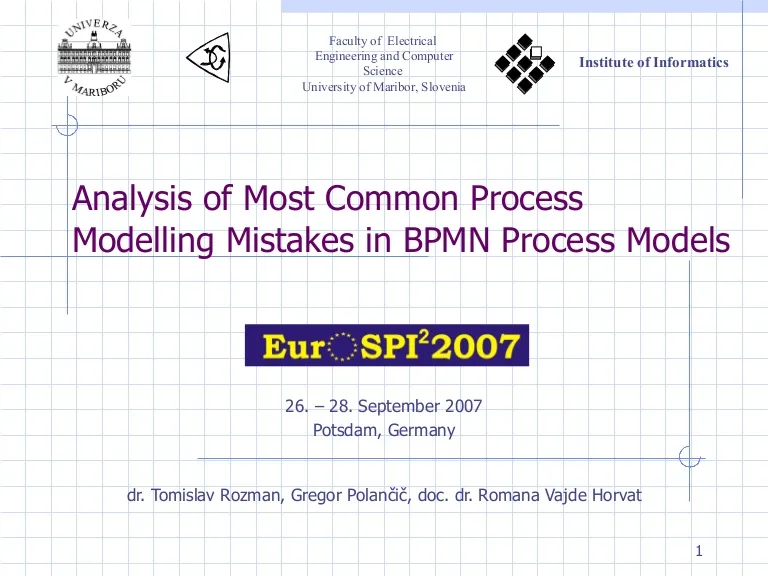Analysis of Most Common Process Modelling Mistakes in BPMN Process Models
Transcript
Analysis of Most Common Process Modelling Mistakes in BPMN Process Models dr. Tomislav Rozman, Gregor Polančič, doc. dr. Romana Vajde Horvat 26. – 28. September 2007 Potsdam, Germany Faculty of Electrical Engineering and Computer Science University of Maribor, Slovenia Institute of Informatics Contents of the article
- Introduction
- What is Business Process Management & Modelling
- A little bit of history
- Similar work
- Research method
- Findings – process model antipatterns
- Conclusion s
- Discussion
- ... a field of knowledge at the intersection between management and information technology, encompassing methods, techniques and tools to design, enact, control, and analyze operational business processes involving humans, organizations, applications, documents and other sources of information 1 or
- ...most overused word in the last few years?
- Better: Discrete process modelling
- Goal: to capture the knowledge how people (machines) perform their work (or, how we would like them to perform it)
- M ain purpose : to ensure at least repeatability of organisation's processes
- Plethora of methods, methodologies, notations,…
- ... but n o silver bullet
- EPC ,
- ARIS ,
- UML Activity diagrams ,
- OPM – Object Process Methodology ,
- BPMN – Business Process Modelling notation
- Visual representation of (business) processes - workflow
- It defines graphical symbols and additional attributes for process description
- Covers the process modelling concepts and patterns very well
- Easy to learn
- Based on : EPC, Petri nets, Activity diagrams (UML)
- Defines the mapping to execution languages (XPDL, BPEL4WS)
- Merging with UML?
- BPMN notation has been taught since 2001 (University of Maribor, Faculty of electrical engineering and computer science)
- BSc. Students of Information Systems, 8 th semester “ Information processing organization and management” practical lectures
- The aim: (business) processes modeling , software standards, software projects organisation
- The modeling tool : Modified Microsoft Visio (‘’in-house’ symbols stencil)
- Project ‘anti-pattern’
- = a pitfall, or, set of classes of commonly-reinvented bad solutions to problems
- = commonly repeated bad practices
- workflow patterns
- control flow patterns, resource patterns, data patterns and exception handling patterns
- BPMN does not prevent us to design bad process models, including syntactical, semantic and pragmatically errors.
- P oor quality of process models can cause poor quality software requirements resulting in a poor information system .
- Research question: What are the most common mistakes when modelling business process diagrams using BPMN notation?
- a multiple case study research
- Analysis of t he process models ( designed by students ) from 2002 to 2007 by three independent persons
- Extraction & classification of most common mistakes -> process anti-pattern
- Syntactical, semantic and pragmatic mistakes
- A set of 15 proces model anti-patterns
- Connecting elements (1-9)
- Other mistakes (9-15)
- Description of the antipatterns:
- Name,
- Possible practical impacts ,
- Type of error ,
- Proposed solution .
- We identified unique collection of most common process modelling mistakes or anti-patterns
- Possible p ractical problems:
- unwanted delays in the process performance,
- non-execution of the activities or
- simply ambiguity which could hinder the process performers at their work
- Practical implications:
- Improvement of the learning materials
- Design of A2 poster with anti-patterns & solutions
- Possible improvement of the BPMN
- Improvements of BPMN modelling tool: verification!
- Discussion
